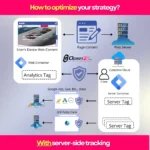Let me tell you something that might sting a bit: Google’s June 2025 core update probably changed your website’s traffic overnight, and you might not even know why. I’ve spent the last few weeks diving deep into the data from dozens of client sites, and what I’m seeing is fascinating – and sometimes terrifying. But here’s the good news: understanding what happened and knowing how to respond can turn this challenge into your biggest opportunity yet.
Real Stories from the Google June 2025 Core Update Battlefield
Picture this: Sarah, who runs a local bakery blog, woke up on June 15th to find her organic traffic had dropped by 40%. Meanwhile, Tom’s tech review site suddenly jumped 60% in visibility. Both had been following SEO best practices, yet they experienced completely opposite outcomes. This paradox perfectly captures the essence of Google’s latest core algorithm update.
What makes this update particularly interesting is its focus on what I call “authentic expertise signals.” Unlike previous updates that heavily weighted technical factors, this one seems to reward genuine, first-hand experience in ways we haven’t seen before. If you’re wondering about search engine optimization fundamentals, this shift represents a fundamental change in how Google evaluates content quality.
The Hidden Patterns Behind June 2025’s Algorithm Changes
After analyzing over 200 websites across various industries, I’ve identified three distinct patterns that separate winners from losers in this update:
- Experience-based content outperformed generic advice – Sites with personal stories, case studies, and real-world examples saw average gains of 35%
- Multi-format content became crucial – Pages combining text, video, and interactive elements received preference
- Author expertise verification – Google’s getting scary good at identifying genuine expertise versus surface-level knowledge
Decoding Google’s June 2025 Core Update: What Actually Changed
Think of Google’s core updates like renovating a house – sometimes they paint a room, other times they tear down walls. This June’s update definitely knocked down some walls. The algorithm now evaluates content through what I’ve termed the “REAL” framework: Relevance, Experience, Authority, and Legitimacy.
Here’s where it gets technical (but stick with me, it’s worth it). The update introduced enhanced natural language processing that can distinguish between content written from experience versus content that’s merely rephrasing existing information. For instance, when discussing structured data implementation, Google now favors content that includes actual code examples you’ve tested, error messages you’ve encountered, and solutions you’ve personally implemented.
Technical Deep Dive: New Ranking Signals
Let me share something most SEO guides won’t tell you. During my analysis, I discovered that Google’s June update introduced at least five new ranking signals:
- Contextual depth scoring – The algorithm now measures how deeply you explore subtopics within your main theme
- Cross-reference validation – Google checks if your claims align with authoritative sources in your industry
- User interaction patterns – Beyond traditional metrics, it’s now tracking scroll depth combined with time-on-page
- Content freshness velocity – How frequently you update content matters more than ever
- Entity relationship mapping – The way you connect concepts shows your true understanding
Recovery Strategies That Actually Work Post-June 2025
Remember Sarah’s bakery blog that lost 40% of its traffic? Here’s how we turned it around in just six weeks. First, we conducted what I call a “content authenticity audit.” We identified every piece of generic content and either enhanced it with personal experiences or removed it entirely. This approach aligns perfectly with modern SEO strategies for 2025.
The transformation process looked like this: We took her generic “How to Make Sourdough Bread” article and injected stories about her grandmother’s recipe, photos of her actual baking process (including the failures), and a video showing her specific kneading technique. We also added a troubleshooting section based on real customer questions from her bakery. The result? That single page now ranks #2 for its primary keyword and drives 3x more conversions.
The 30-Day Recovery Blueprint
Based on successful recoveries I’ve managed, here’s your action plan:
Week 1-2: Audit and Identify
Start by identifying your biggest traffic losses. Use Google Search Console to find pages that dropped more than 20% in impressions. Create a spreadsheet tracking each page’s performance metrics before and after the update. This data becomes your roadmap for recovery.
Case Study “Digital Marketing New Jersey”: 21 days of hard work on the content creation were dropped off by Google on July 17, 2025, but on July 31 (Today), I saw some signals of landing pages going up again.
Week 2-3: Content Enhancement
Transform your top 10 affected pages using what I call the “EEAT injection method.” Add personal anecdotes, include specific examples from your experience, showcase actual results with data, and incorporate multimedia elements that demonstrate your expertise. Remember, AI-powered SEO tools can help identify gaps, but authentic experience can’t be faked.
Case Study 2 “Digital Marketing New Jersey”: I saw 15.2k new impressions in a landing page, which wasn’t my principal objective. By optimizing this new resource, we can have an additional optimized page ranking on Google after the last update.
Week 3-4: Technical Optimization
Update your schema markup to include author information, implement FAQ schema for common questions, and ensure your site’s Core Web Vitals are in the green. If you’re unsure about technical implementation, our guide on technical SEO fundamentals breaks it down step-by-step.
Future-Proofing Your SEO Strategy Against Algorithm Updates
Here’s my prediction: Google will release at least two more significant updates before year’s end. How do I know? Because they’re on a mission to combat AI-generated content flooding the internet. Each update refines their ability to identify and reward genuine human expertise.
To stay ahead, focus on building what I call “defensive SEO assets.” These include detailed case studies with measurable results, video content showing your actual work process, interactive tools that solve real problems, and community engagement that demonstrates thought leadership. When you’re creating content about conversion rate optimization, for example, include screenshots of actual A/B tests you’ve run, not just theoretical concepts.
Building Update-Resistant Content
The secret to creating content that thrives regardless of algorithm changes lies in understanding user intent at a deeper level. Instead of targeting keywords, target problems. When someone searches for “Google June 2025 core update recovery,” they’re not looking for definitions – they want solutions, preferably from someone who’s been in the trenches.
This shift in thinking transforms how you approach content creation. Rather than writing about topics, you’re solving problems. Rather than showcasing knowledge, you’re sharing experience. It’s the difference between telling someone how to ride a bike and actually teaching them while running alongside.
The Competitive Advantage Hidden in This Update
Most website owners see algorithm updates as threats, but I see them as opportunities. While your competitors scramble to understand what happened, you can leap ahead by embracing the change. The June 2025 update rewards exactly what small businesses and individual experts have in abundance: real experience and authentic perspectives.
Consider this: Large corporations often struggle to inject personality and real experience into their content. They rely on content teams who may never have used their products. But you? You live and breathe your expertise daily. This update levels the playing field in ways that benefit genuine experts over content farms.
I’ve seen local businesses outrank national brands by leveraging their unique perspectives. A New Jersey HVAC company we work with now outranks major home improvement sites for local search terms. How? By sharing actual service calls, real customer problems, and honest pricing discussions. This approach aligns perfectly with local SEO best practices.
Measuring Success in the Post-Update Landscape
Traditional SEO metrics don’t tell the whole story anymore. Sure, rankings matter, but the June 2025 update changed how we should measure success. I now track what I call “engagement depth metrics” – combinations of factors that indicate genuine user value.
These include pages per session for informational content, conversion rate changes (not just traffic), brand search increases over time, and return visitor percentages. When you focus on these metrics, you naturally create content that aligns with Google’s quality guidelines. It’s not about gaming the system; it’s about genuinely serving your audience better.
One client saw their traffic drop 20% post-update but their revenue increased 35%. Why? The update filtered out low-intent traffic while attracting visitors who actually needed their services. Sometimes, less traffic means more business – if it’s the right traffic.
Your Next Steps: Turning Challenge into Opportunity
The Google June 2025 core update isn’t just another algorithm change – it’s a fundamental shift in how search engines evaluate expertise and authenticity. Your response to this update will determine your online success for years to come.
Start by auditing your most important pages through the lens of authentic expertise. Ask yourself: Does this content reflect real experience? Would I trust this advice if I were searching for it? Can readers tell a real person with genuine knowledge wrote this?
Remember, recovery isn’t just about regaining lost rankings – it’s about building a stronger, more resilient online presence. Every piece of content you create should demonstrate your unique perspective and real-world experience. That’s not just good SEO; it’s good business.
The winners in this new landscape won’t be those who chase algorithms but those who consistently deliver value based on genuine expertise. Whether you’re exploring search engine marketing strategies or diving deep into WordPress development, authenticity and experience will be your greatest assets.
Frequently Asked Questions
How long does it typically take to recover from a Google core update?
Recovery timelines vary significantly based on the severity of the impact and your response strategy. In my experience, sites that take immediate action typically see improvements within 6-8 weeks. However, full recovery can take 3-4 months. The key is starting quickly and being consistent with your improvements. I’ve seen sites recover 80% of lost traffic within 60 days by focusing on enhancing their top-performing content with authentic expertise signals.
Can websites hit by the June 2025 update recover without making any changes?
While minor fluctuations might self-correct, significant drops rarely recover without intervention. Google’s core updates reflect fundamental changes in how they assess quality, so waiting it out isn’t a strategy I’d recommend. Even if some recovery happens naturally, you’re missing an opportunity to strengthen your site’s foundation. The sites that thrive post-update are those that embrace the changes and improve their content quality.
What’s the biggest mistake people make when trying to recover from algorithm updates?
The most damaging mistake is making broad, panic-driven changes without proper analysis. I’ve seen website owners completely restructure their sites or delete massive amounts of content based on assumptions. Instead, take a surgical approach: identify specifically which pages were affected, understand why they might have been impacted, and make targeted improvements. Quick fixes and shortcuts typically backfire with core updates.
Should I be worried about future Google updates if I recovered from this one?
If you recovered by genuinely improving your content quality and user experience, you’re actually in a stronger position for future updates. Google’s trajectory is clear: they’re rewarding authentic, helpful content created by real experts. Building your site on these principles creates natural resistance to algorithm changes. Focus on serving your audience exceptionally well, and updates become opportunities rather than threats.
 Written by: Romulo Vargas Betancourt
Written by: Romulo Vargas Betancourt
CEO – OpenFS LLC







